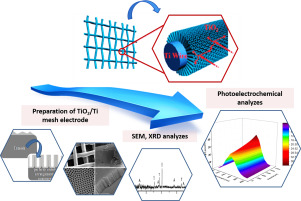当前位置:
X-MOL 学术
›
J. Electroanal. Chem.
›
论文详情
Our official English website, www.x-mol.net, welcomes your
feedback! (Note: you will need to create a separate account there.)
3D nanoporous titania formed by anodization as a promising photoelectrode material
Journal of Electroanalytical Chemistry ( IF 4.1 ) Pub Date : 2018-08-01 , DOI: 10.1016/j.jelechem.2018.06.014 Joanna Kapusta-Kołodziej , Adrianna Chudecka , Grzegorz D. Sulka
Journal of Electroanalytical Chemistry ( IF 4.1 ) Pub Date : 2018-08-01 , DOI: 10.1016/j.jelechem.2018.06.014 Joanna Kapusta-Kołodziej , Adrianna Chudecka , Grzegorz D. Sulka

|
Abstract Nanoscale control of the growth of inorganic metal oxides determines their structures and properties, and leads to development of novel nanostructured materials with fundamental and practical importance from a point of view their further applications. After anodic aluminum oxide, the next nanoporous material which has attracted tremendous interest of researchers around the world, is nanoporous anodic titanium oxide (ATO) formed by anodization. The main objective of this work was to investigate the ability of formation of anodic titanium oxide structures, particularly in the form of TiO2 nanopore arrays on 3D titanium substrates (Ti mesh) in viscous electrolyte containing fluoride ions. Three-dimensional (3D) TiO2 nanopore arrays grown on Ti mesh were prepared via two-step electrochemical anodization process, and the effect of anodizing potential and duration of the process on the formation of ATO layers on titanium mesh were investigated. The 3D TiO2 nanopore arrays on Ti mesh were characterized by using field emission scanning electron microscopy and X-ray diffraction (XRD) technique. The results showed that the optimized anodization conditions for preparation of titanium dioxide nanopore arrays are 40 and 50 V of the applied potential, and 10 min of time processing. The effect of annealing temperature of ATO layers on their morphology and phase composition was also investigated in detail. The amorphous ATO layers on titanium mesh transform to anatase phase at 400 °C and further to rutile phase at 600 °C. However, photoelectrochemical tests demonstrated that the best photoelectrochemical performance of fabricated 3D photoanodes was observed for the samples anodized at 40 V or 50 V for 10 min, and annealed at 400 °C. The photoelectrochemical properties of the mesh-based and typical plate TiO2/Ti electrodes were compared. It was found that the higher photoconversion efficiency was observed for the 3D TiO2/Ti mesh electrode than for a typical plate TiO2/Ti electrode. It is expected that anodizing of three dimensional (3D) Ti substrates will offer an opportunity to enhance various properties of anodic titanium oxide, especially its photoactivity.
中文翻译:

通过阳极氧化形成的 3D 纳米多孔二氧化钛作为一种有前途的光电极材料
摘要 无机金属氧化物生长的纳米级控制决定了它们的结构和性质,并导致开发具有基础和实际重要性的新型纳米结构材料,从其进一步应用的角度来看。在阳极氧化铝之后,下一个引起世界各地研究人员极大兴趣的纳米多孔材料是通过阳极氧化形成的纳米多孔阳极氧化钛 (ATO)。这项工作的主要目的是研究阳极氧化钛结构的形成能力,特别是在含有氟离子的粘性电解质中,在 3D 钛基板(Ti 网)上形成 TiO2 纳米孔阵列的能力。通过两步电化学阳极氧化工艺制备在 Ti 网上生长的三维 (3D) TiO2 纳米孔阵列,并研究了阳极氧化电位和工艺持续时间对钛网上 ATO 层形成的影响。通过使用场发射扫描电子显微镜和 X 射线衍射 (XRD) 技术对 Ti 网格上的 3D TiO2 纳米孔阵列进行了表征。结果表明,制备二氧化钛纳米孔阵列的优化阳极氧化条件为外加电压为40和50 V,处理时间为10 min。还详细研究了ATO层的退火温度对其形貌和相组成的影响。钛网上的非晶 ATO 层在 400 °C 时转变为锐钛矿相,并在 600 °C 时进一步转变为金红石相。然而,光电化学测试表明,对于在 40 V 或 50 V 下阳极氧化 10 分钟并在 400 °C 下退火的样品,观察到制造的 3D 光阳极的最佳光电化学性能。比较了网状和典型板状 TiO2/Ti 电极的光电化学性能。发现 3D TiO2/Ti 网状电极比典型的板状 TiO2/Ti 电极具有更高的光转换效率。预计三维 (3D) Ti 基材的阳极氧化将为增强阳极氧化钛的各种性能,尤其是其光活性提供机会。发现 3D TiO2/Ti 网状电极比典型的板状 TiO2/Ti 电极具有更高的光转换效率。预计三维 (3D) Ti 基材的阳极氧化将为增强阳极氧化钛的各种性能,尤其是其光活性提供机会。发现 3D TiO2/Ti 网状电极比典型的板状 TiO2/Ti 电极具有更高的光转换效率。预计三维 (3D) Ti 基材的阳极氧化将为增强阳极氧化钛的各种性能,尤其是其光活性提供机会。
更新日期:2018-08-01
中文翻译:

通过阳极氧化形成的 3D 纳米多孔二氧化钛作为一种有前途的光电极材料
摘要 无机金属氧化物生长的纳米级控制决定了它们的结构和性质,并导致开发具有基础和实际重要性的新型纳米结构材料,从其进一步应用的角度来看。在阳极氧化铝之后,下一个引起世界各地研究人员极大兴趣的纳米多孔材料是通过阳极氧化形成的纳米多孔阳极氧化钛 (ATO)。这项工作的主要目的是研究阳极氧化钛结构的形成能力,特别是在含有氟离子的粘性电解质中,在 3D 钛基板(Ti 网)上形成 TiO2 纳米孔阵列的能力。通过两步电化学阳极氧化工艺制备在 Ti 网上生长的三维 (3D) TiO2 纳米孔阵列,并研究了阳极氧化电位和工艺持续时间对钛网上 ATO 层形成的影响。通过使用场发射扫描电子显微镜和 X 射线衍射 (XRD) 技术对 Ti 网格上的 3D TiO2 纳米孔阵列进行了表征。结果表明,制备二氧化钛纳米孔阵列的优化阳极氧化条件为外加电压为40和50 V,处理时间为10 min。还详细研究了ATO层的退火温度对其形貌和相组成的影响。钛网上的非晶 ATO 层在 400 °C 时转变为锐钛矿相,并在 600 °C 时进一步转变为金红石相。然而,光电化学测试表明,对于在 40 V 或 50 V 下阳极氧化 10 分钟并在 400 °C 下退火的样品,观察到制造的 3D 光阳极的最佳光电化学性能。比较了网状和典型板状 TiO2/Ti 电极的光电化学性能。发现 3D TiO2/Ti 网状电极比典型的板状 TiO2/Ti 电极具有更高的光转换效率。预计三维 (3D) Ti 基材的阳极氧化将为增强阳极氧化钛的各种性能,尤其是其光活性提供机会。发现 3D TiO2/Ti 网状电极比典型的板状 TiO2/Ti 电极具有更高的光转换效率。预计三维 (3D) Ti 基材的阳极氧化将为增强阳极氧化钛的各种性能,尤其是其光活性提供机会。发现 3D TiO2/Ti 网状电极比典型的板状 TiO2/Ti 电极具有更高的光转换效率。预计三维 (3D) Ti 基材的阳极氧化将为增强阳极氧化钛的各种性能,尤其是其光活性提供机会。











































 京公网安备 11010802027423号
京公网安备 11010802027423号